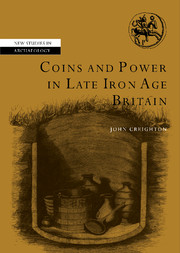Book contents
- Frontmatter
- Contents
- List of figures
- List of tables
- Preface
- Acknowledgements
- List of abbreviations
- Note on translations used
- Introduction
- 1 The Middle to Late Iron Age transition
- 2 Coin and the representation of individual authority
- 3 The Southern and Eastern kingdoms
- 4 Classical imagery and ideology in Britain
- 5 The location of Britain in the Roman world
- 6 Legends and language
- 7 Dynasties and identities
- 8 Conclusion and epilogue: from Britain to Britannia
- Appendix: A brief introduction to Iron Age coinage in Britain
- References
- Index of coin types
- General index
- NEW STUDIES IN ARCHAEOLOGY
8 - Conclusion and epilogue: from Britain to Britannia
Published online by Cambridge University Press: 22 September 2009
- Frontmatter
- Contents
- List of figures
- List of tables
- Preface
- Acknowledgements
- List of abbreviations
- Note on translations used
- Introduction
- 1 The Middle to Late Iron Age transition
- 2 Coin and the representation of individual authority
- 3 The Southern and Eastern kingdoms
- 4 Classical imagery and ideology in Britain
- 5 The location of Britain in the Roman world
- 6 Legends and language
- 7 Dynasties and identities
- 8 Conclusion and epilogue: from Britain to Britannia
- Appendix: A brief introduction to Iron Age coinage in Britain
- References
- Index of coin types
- General index
- NEW STUDIES IN ARCHAEOLOGY
Summary
Conclusion
In the past many of the narratives of this period have attempted to reconstruct history in terms of the rise and fall of individual kingdoms. Kent was seen as a territory, independent at first under Dubnovellaunos, then taken over by the rulers north of the Thames. In the years after Tasciovanus' death (Van Arsdell's ‘Interregnum’), the Southern dynasty wrestled control of Kent under Eppillus, only to be ejected again by Cunobelin and his son Amminus. Soon other territories of the Southern dynasty fell as Cunobelin's brother Epaticcus and son Caratacus moved into Berkshire and northern Hampshire. Details vary, but these are all written with a rhetoric of conquest, expansion and defeat. As Rankin (1996:215) represented it: ‘Pre-Claudian Britain is a landscape of dynastic strife and constant warfare.’
I reject this way of attempting to reconstruct this period. Warfare may indeed have been prevalent in the later second and early first centuries BC, as equestrian groups appeared in the archaeological record and disrupted the MIA way of life (chapters 1 and 2). However after 54 BC I believe that changed. South-east Britain had been conquered by Caesar. It was up to Caesar and the senate to decide what to do next, whether to turn the territory into a province or whether to establish it as one or more friendly kingdoms. After this date we saw that all the pre-existing gold coinage in the region was recalled and re-issued in new series bearing a new family of imagery.
- Type
- Chapter
- Information
- Coins and Power in Late Iron Age Britain , pp. 216 - 221Publisher: Cambridge University PressPrint publication year: 2000

